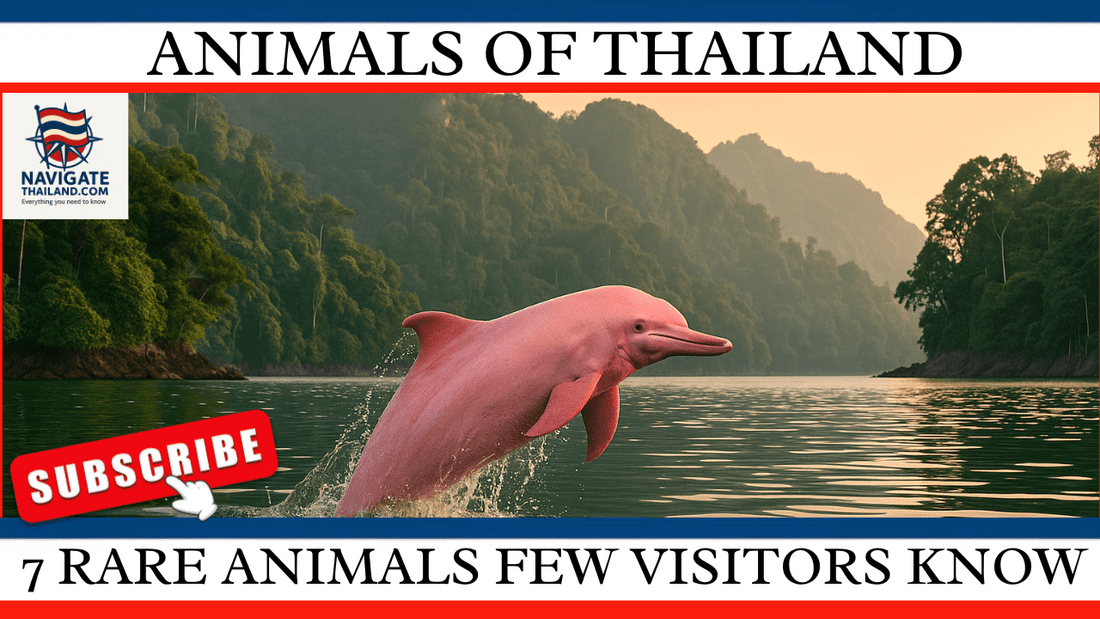
Beyond Elephants: 7 Rare Thai Species Few Visitors Know
Share
When travellers think of Thai wildlife, elephants usually steal the spotlight. But Thailand’s ecosystems — from the Andaman coast to the northern jungles — are home to some of the world’s most fascinating and lesser-known creatures.
From tree-dwelling primates with saucer eyes to coral-coloured crabs that glow in the dark, these animals reveal a side of Thailand few tourists ever see.
Here are seven rare Thai species you probably haven’t heard of — and where to find them responsibly in 2026.
1. Irrawaddy Dolphin (ปลาโลมาหัวบาตร)
Where to see them: Trang Province, Khanom Bay (Nakhon Si Thammarat), and along the Mekong River in Ubon Ratchathani.
Unlike the sleek bottlenose dolphins seen in aquariums, Irrawaddy dolphins have rounded foreheads and small dorsal fins. They prefer estuaries and river mouths rather than open ocean.
They’re incredibly shy — if you spot one surfacing for air, consider yourself lucky.
Status: Endangered. Threatened by fishing nets and coastal development.
Fun fact: They can spit jets of water to herd fish!
2. Sunda Pangolin (ตัวนิ่ม)
Where to see them: Rare sightings in Khao Yai and Kaeng Krachan National Parks.
Covered head-to-tail in keratin scales, the Sunda pangolin looks like a walking pinecone. They’re nocturnal and feed exclusively on ants and termites.
Status: Critically endangered. Victim of illegal wildlife trade.
Traveller tip: Never support markets or souvenirs featuring pangolin scales or claws — it’s illegal and devastating to conservation.
3. Dugong (พะยูน)
Where to see them: Trang’s Hat Chao Mai National Park and Koh Libong.
These gentle “sea cows” graze on seagrass in shallow coastal waters. Thailand’s southern Andaman Sea hosts one of the largest remaining dugong populations in Southeast Asia.
Local communities are now leading conservation efforts — visitors can join eco-tours that monitor populations and restore seagrass beds.
Status: Vulnerable.
4. Bengal Slow Loris (ลิงลม)
Where to see them: Dense forests in Khao Sok National Park and Chiang Rai’s hill jungles.
This wide-eyed nocturnal primate moves silently through the trees. Unlike most monkeys, it produces a mild toxin from glands near its elbows — a rare trait in mammals!
They’re often poached for the pet trade or used in illegal wildlife selfies — avoid any tourism operators offering loris encounters.
Status: Vulnerable.
5. Sarus Crane (นกกระเรียน)
Where to see them: Buriram Province and wetlands of Nong Han Kumphawapi, Udon Thani.
The Sarus crane, the world’s tallest flying bird, vanished from Thailand for decades. But thanks to a national breeding and rewilding program, these elegant red-headed cranes have made a comeback in the wild.
Status: Vulnerable but rising.
Fun fact: Sarus cranes mate for life and perform courtship dances that inspired traditional Thai folk art.
6. Pink Dolphin (โลมาสีชมพู)
Where to see them: Khanom Bay (Nakhon Si Thammarat) and the Gulf of Thailand.
This rare subspecies of the Indo-Pacific humpback dolphin gets its pink colour from blood vessels close to the skin. Locals call them “Pla Loma See Chompoo” — the pink dolphins of Khanom.
Boat tours now focus on eco-viewing, limiting noise and maintaining respectful distances to avoid stress on the pod.
Status: Near threatened.
7. Sirindhorn Crab (ปูเจ้าฟ้าสิรินธร)
Where to see them: Kaeng Krachan National Park.
Discovered only recently, this tiny bright-purple freshwater crab was named after Princess Maha Chakri Sirindhorn. It lives in highland streams within thick forest.
Status: Endangered and extremely localized.
Fun fact: It’s become a national symbol of conservation and is featured on park signs and school programs in western Thailand.
CONSERVATION NOTE: WHY THESE SPECIES MATTER
Thailand’s biodiversity is among the richest in Asia — but many species face extinction from habitat loss, pollution, and illegal trade.
By supporting ethical wildlife tours, national park entry fees, and local eco-projects, travellers directly contribute to preserving this fragile ecosystem.
Remember: seeing these rare creatures in the wild is a privilege, not a right.
QUICK GUIDE: WHERE TO SEE RARE WILDLIFE IN THAILAND
|
Region |
National Park / Area |
Notable Species |
|
South (Andaman & Gulf) |
Khanom, Trang, Khao Sok |
Pink Dolphin, Dugong, Slow Loris |
|
Central & West |
Kaeng Krachan, Khao Yai |
Pangolin, Gibbons, Sirindhorn Crab |
|
North |
Chiang Rai, Chiang Mai |
Slow Loris, Rare Birds |
|
Northeast (Isaan) |
Buriram, Udon Thani |
Sarus Crane, Irrawaddy Dolphin (Mekong) |
FINAL THOUGHTS
Beyond Thailand’s elephants and temples lies an entire hidden world of wildlife waiting to be discovered.
From pink dolphins gliding through warm waters to cranes dancing under Isaan skies, these creatures remind us why Thailand’s biodiversity is so precious — and why it needs our protection.
Travel slow. Look deeper. See Thailand’s wild heart.
Explore Thailand’s Wild Side
Download our 2026 Thailand Travel Guide, bundle it with our Budget Travel Itinerary Packs, and get insider tips on food, transport, and hidden gems.
Travel more. Spend less. Love Thailand.
Want to dig deeper into Thailand?
Check out our Thailand guide series below.
Discover our Thailand guide series:

Find out more about our Thai Culture & Travel guide collection here.
Explore Thailand with our Tailored Itineraries bundle.

Explore Thailands best and unexplored islands with our Island-hopping Thailand collection.




















































































































































